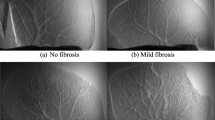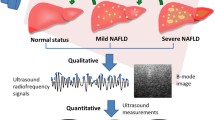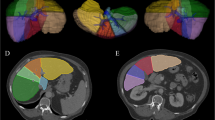Abstract
Purpose
Noninvasive assessment of significant liver fibrosis in rabbits by spectral CT parameters and texture analysis.
Materials and methods
Thirty-three rabbits were randomly divided into 27 carbon tetrachloride-induced liver fibrosis group and 6 control group. Spectral CT contrast-enhanced scan was performed in batches, and the liver fibrosis was staged according to the histopathological results. The portal venous phase spectral CT parameters [70 keV CT value, normalized iodine concentration (NIC), spectral HU curve slope (λHU)] were measured, and MaZda texture analysis was performed on 70 keV monochrome images. Three dimensionality reduction methods and four statistical methods in B11 module were used to perform discriminant analysis and calculate misclassified rate (MCR), and ten texture features under the lowest combination of MCR were statistically analyzed. Receiver operating characteristic curve (ROC) was used to calculate the diagnostic performance of spectral parameters and texture features for significant liver fibrosis. Finally, the binary logistic regression was used to further screen independent predictors and establish model.
Results
A total of 23 experimental rabbits and 6 control rabbits were included, of which 16 had significant liver fibrosis. Three spectral CT parameters with significant liver fibrosis were significantly lower than those of non-significant liver fibrosis (p < 0.05), and the AUC ranged from 0.846 to 0.913. The combination analysis of mutual information (MI) and nonlinear discriminant analysis (NDA) had the lowest MCR, which with 0%. In the filtered texture features, four were statistically significant and AUC > 0.5, ranges from 0.764 to 0.875. The logistic regression model showed that Perc.90% and NIC could be used as independent predictors, the overall prediction accuracy of the model was 89.7% and the AUC was 0.976.
Conclusion
Spectral CT parameters and texture features have high diagnostic value for predicting significant liver fibrosis in rabbits, and the combination of the two can improve its diagnostic efficiency.








Similar content being viewed by others
References
Seitz T, Hellerbrand C. Role of fibroblast growth factor signalling in hepatic fibrosis. Liver Int. 2021;41(6):1201–15.
Dhar D, Baglieri J, Kisseleva T, Brenner DA. Mechanisms of liver fibrosis and its role in liver cancer. Exp Biol Med (Maywood). 2020;245(2):96–108.
Lubner MG, Jones D, Kloke J, Said A, Pickhardt PJ. CT texture analysis of the liver for assessing hepatic fibrosis in patients with hepatitis C virus. Br J Radiol. 2019;92(1093):20180153.
Prasoppokakorn T, Chan WK, Wong VW, Pitisuttithum P, Mahadeva S, Nik Mustapha NR, et al. Validation model of fibrosis-8 index score to predict significant fibrosis among patients with nonalcoholic fatty liver disease. World J Gastroenterol. 2022;28(15):1563–73.
Sharma S, Khalili K, Nguyen GC. Non-invasive diagnosis of advanced fibrosis and cirrhosis. World J Gastroenterol. 2014;20(45):16820–30.
Goo HW, Goo JM. Dual-Energy CT: New Horizon in Medical Imaging. Korean J Radiol. 2017;18(4):555–69.
Gourtsoyianni S, Santinha J, Matos C, Papanikolaou N. Diffusion-weighted imaging and texture analysis: current role for diffuse liver disease. Abdom Radiol (NY). 2020;45(11):3523–31.
Choi B, Choi IY, Cha SH, Yeom SK, Chung HH, Lee SH, et al. Feasibility of computed tomography texture analysis of hepatic fibrosis using dual-energy spectral detector computed tomography. Jpn J Radiol. 2020;38(12):1179–89.
Lubner MG, Malecki K, Kloke J, Ganeshan B, Pickhardt PJ. Texture analysis of the liver at MDCT for assessing hepatic fibrosis. Abdom Radiol (NY). 2017;42(8):2069–78.
Xu X, Zhu H, Li R, Lin H, Grimm R, Fu C, et al. Whole-liver histogram and texture analysis on T1 maps improves the risk stratification of advanced fibrosis in NAFLD. Eur Radiol. 2021;31(3):1748–59.
Zhao R, Gong XJ, Ge YQ, Zhao H, Wang LS, Yu HZ, et al. Use of texture analysis on noncontrast MRI in classification of early stage of liver fibrosis. Can J Gastroenterol Hepatol. 2021;2021:6677821.
Li J, Zhao S, Ling Z, Li D, Jia G, Zhao C, et al. Dual-energy computed tomography imaging in early-stage hepatocellular carcinoma: a preliminary study. Contrast Media Mol Imaging. 2022;2022:2146343.
Szczypiński PM, Strzelecki M, Materka A, Klepaczko A. MaZda–a software package for image texture analysis. Comput Methods Programs Biomed. 2009;94(1):66–76.
Goodman ZD. Grading and staging systems for inflammation and fibrosis in chronic liver diseases. J Hepatol. 2007;47(4):598–607.
Jian ZC, Long JF, Liu YJ, Hu XD, Liu JB, Shi XQ, et al. Diagnostic value of two dimensional shear wave elastography combined with texture analysis in early liver fibrosis. World J Clin Cases. 2019;7(10):1122–32.
Roehlen N, Crouchet E, Baumert TF. Liver Fibrosis: Mechanistic Concepts and Therapeutic Perspectives. Cells. 2020; 9(4).
Parola M, Pinzani M. Liver fibrosis: pathophysiology, pathogenetic targets and clinical issues. Mol Aspects Med. 2019;65:37–55.
Ronot M, Leporq B, Van Beers BE, Vilgrain V. CT and MR perfusion techniques to assess diffuse liver disease. Abdom Radiol (NY). 2020;45(11):3496–506.
Lin LY, Zhang F, Yu Y, Fu YC, Tang DQ, Cheng JJ, et al. Noninvasive evaluation of hypoxia in rabbit VX2 lung transplant tumors using spectral CT parameters and texture analysis. Jpn J Radiol. 2022;40(3):289–97.
Liu XW, Liu H, Deng LN, Li SL, Xue CQ, Deng J, et al. Application of basis material decomposition technique with spectral CT in quantitatively evaluating the stage of hepatitis B liver fibrosis. Chin J Med Phys. 2022;39(06):701–4.
Lv P, Lin X, Gao J, Chen K. Spectral CT: preliminary studies in the liver cirrhosis. Korean J Radiol. 2012;13(4):434–42.
Daginawala N, Li B, Buch K, Yu H, Tischler B, Qureshi MM, et al. Using texture analyses of contrast enhanced CT to assess hepatic fibrosis. Eur J Radiol. 2016;85(3):511–7.
Lubner MG, Smith AD, Sandrasegaran K, Sahani DV, Pickhardt PJ. CT texture analysis: definitions, applications, biologic correlates, and challenges. Radiographics. 2017;37(5):1483–503.
Wang H, Lian YW, Yan XJ, He WR, Deng J. The value of dynamic contrast-enhanced MRI texture analysis in preoperative prediction of the expression of Ki-67 in hepatocellular carcinoma. Radio Practice. 2022;37(06):729–33.
Shen L, Fu H, Tao G, Liu X, Yuan Z, Ye X. Pre-immunotherapy contrast-enhanced ct texture-based classification: a useful approach to non-small cell lung cancer immunotherapy efficacy prediction. Front Oncol. 2021;11: 591106.
Hu X, Zhou R, Hu M, Wen J, Shen T. Differentiation and prediction of pneumoconiosis stage by computed tomography texture analysis based on U-Net neural network. Comput Methods Programs Biomed. 2022;225: 107098.
Yue Y, Hu F, Hu T, Sun Y, Tong T, Gu Y. Three-dimensional ct texture analysis to differentiate colorectal signet-ring cell carcinoma and adenocarcinoma. Cancer Manag Res. 2019;11:10445–53.
Luo C, Song Y, Liu Y, Wang R, Gao J, Yue S, et al. Analysis of the value of enhanced CT combined with texture analysis in the differential diagnosis of pulmonary sclerosing pneumocytoma and atypical peripheral lung cancer: a feasibility study. BMC Med Imaging. 2022;22(1):16.
Feng M, Zhang M, Liu Y, Jiang N, Meng Q, Wang J, et al. Texture analysis of MR images to identify the differentiated degree in hepatocellular carcinoma: a retrospective study. BMC Cancer. 2020;20(1):611.
Fang WH, Li XD, Zhu H, Miao F, Qian XH, Pan ZL, et al. Resectable pancreatic ductal adenocarcinoma: association between preoperative CT texture features and metastatic nodal involvement. Cancer Imaging. 2020;20(1):17.
Funding
This work was supported by Natural Science Foundation of Shanghai (Research Grant No.19ZR1452400) and National Natural Science Foundation of China (Research Grant No. 81673743).
Author information
Authors and Affiliations
Contributions
Conception and study design: XRG, YXG and MGZ. Data collection and analysis: XRG, YXG, TTZ and QS. Manuscript writing: XRG, YXG, TTZ, DWX, QS and MGZ. Administrative support: DWX, QS and MGZ. All authors read and approved the final manuscript.
Corresponding authors
Ethics declarations
Conflict of interest
The authors declare that they have no conflict of interest.
Ethical statement
This study was approved by Shanghai Municipal Hospital of Traditional Chinese Medicine, Shanghai University of Traditional Chinese Medicine. All study procedures were in accordance with the Statement of Human and Animal Rights.
Additional information
Publisher's Note
Springer Nature remains neutral with regard to jurisdictional claims in published maps and institutional affiliations.
About this article
Cite this article
Gong, X., Guo, Y., Zhu, T. et al. Noninvasive assessment of significant liver fibrosis in rabbits by spectral CT parameters and texture analysis. Jpn J Radiol 41, 983–993 (2023). https://doi.org/10.1007/s11604-023-01423-0
Received:
Accepted:
Published:
Issue Date:
DOI: https://doi.org/10.1007/s11604-023-01423-0




